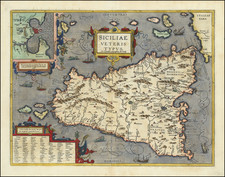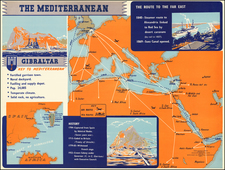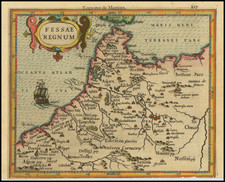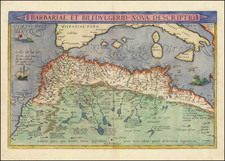Picturing the Medici’s Grand Hall of Maps
Finely-executed nineteenth-century copy of Stefano Buonsignori’s painting of the coast of North Africa and Sicily.
The original map is part of the set which adorns the famous Medici Sala di Guardaroba, or Sala delle Carte Geografiche (Hall of Maps) in the Palazzo Vecchio in Florence. At the time of its creation, it was at the cutting edge of cartographic content for the region, This later painting was executed by Bartolomeo Silvestri, a renowned restorer best known for his work on the Teatro della Pergola. The original artist and the skilled copyist, and the date of the facsimile’s creation (1809), are credited in a note in the upper right corner.
The map’s coloring is striking, with a strong contrast between the dark, rich blue of the Mediterranean and the pinks and greens of the land. Sicily and a sliver of Sardinia are in the north, with the important harbor of Malta nearby.
The African coast shows the populated littoral, dotted with towns, but the landscape turns to desert inland. The coast includes part of Numidia, an ancient political entity that today lies on the coast of Tunisia. To the east is Cyrenaica, which corresponds to modern Libya, including Tripoli. Cyrenaica was colonized by the Greeks and then ruled by the Persians, the Ptolemaics, and the Romans. At the eastern edge of the map is Marmarica, also part of the Roman Empire.
Filling the desert is an elaborate decorative cartouche, outlining the history and geography of the region.
Bartolomeo Silvestri (1781-1851) painted copies of the maps over the course of 1808 and 1809. Many of the surviving examples are today held in Italian institutional collections. This is one of the few to be offered privately.
The Medici Hall of Maps
The original painting adorns one of the cabinets in the Sala di Guardaroba, or storage room, in the Palazzo Vecchio. There are 53 maps painted on the cabinets that line this room. The cabinets are the work of Dionigi Nigetti, and the maps were painted by the aforementioned Buonsignori and Ignazio Danti. The Hall of Maps in what was then known as the Palazzo della Signoria was part of the ambitious building project of the famous Medici family and was supposed to house their treasures in the room’s cabinets.
The Palazzo was first built in 1299. Cosimo I (1519-1574) was elected head of the Florentine Republic in 1537, after the assassination of his cousin, Alessandro. Now Duke of Florence, Cosimo took the reins of power from the senate, assembly, and council, ruling largely alone. He expanded his family and city’s political power, eventually becoming known as Cosimo the Great.
The city itself was transformed by Cosimo’s rule. He consolidated the public services of Florence into one office, housed in a new building, the Uffizi. For this project, Cosimo turned to the architect Giorgio Vasari. Vasari was soon promoted to superintendent of Cosimo’s many building projects, which included the restoration of the Palazzo Vecchio.
One of the most grandiose parts of the restoration was the plan for the Hall of Maps. Vasari employed Ignazio Danti, a priest, mathematician, and mapmaker. They envisioned a room covered in maps and portraits, meant to represent the knowledge of the entire cosmos and the Medici’s prominence within it. Danti painted the first 30 maps between 1563 and 1575. By 1580, Danti had been summoned to Rome where he undertook a similar project for the Pope, resulted in a hall of maps of modern Italy in the newly constructed Gallery of Maps along the Cortile del Belvedere.
After Danti's departure from Florence, Stefano Bonsignori took over, painting 23 maps, including this one. Bonsignori was the granducale cosmographer to Cosimo’s son, Francesco (Francis) I. The room was further decorated with two armillary spheres (including the Santucci sphere, now in the Florence Museum of the History of Science) and a huge terrestrial globe by Danti. A matching celestial globe, and a mechanism to suspend the pair from the ceiling, were never built.
















![Insularum Aliquot Maris Mediterranei Descriptio [Sicily, Malta, Sardinia, Corfu, Elba and Zerbia] (1570A First State)](https://storage.googleapis.com/raremaps/img/small/87925.jpg)